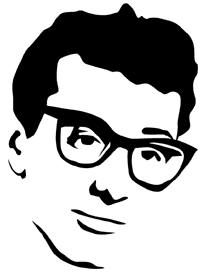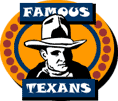
 Buddy Holly
Buddy Holly
|

 Buddy Holly
Buddy Holly
Pioneering rock 'n' roll musician Charles Hardin Holley, known as Buddy Holly, was born in Lubbock, Texas on September 7, 1936. He died in 1959 in a plane crash in Iowa. The youngest of four children of Lawrence and Ella (Drake) Holley, Buddy became one of the greatest legends of rock music.
His father worked as a tailor and salesman in a Lubbock clothing store, and though Lawrence did not play an instrument, he and Buddy's mom encouraged their children's musical skills.
At age five, Buddy appeared with his brothers in a talent show in the neighboring town of County Line. They won five dollars singing "Down the River of Memories." At age eleven Buddy took piano lessons, but quit after nine months. He started studying steel guitar, but eventually taught himself to play on acoustic guitar. At Hutchinson Junior High he and a friend, Bob Montgomery, formed a country music duo that later performed rock-and-roll music.
In the autumn of 1953, the duo added bass player Larry Welborn and started playing weekly on Lubbock radio station KDAV. The program was called "Sunday Party." At Lubbock High, Holly studied printing and drafting. He also worked part-time at Panhandle Steel Products. He stayed focused on his dream, however, of making his living as a musician.
In 1954 and 1955 the band made some demo records in Wichita Falls, but in 1956 Decca offered only Buddy a contract. Decca tried to turn him into a country artist. Two unsuccessful singles later, the label and Buddy parted ways.
Holly returned to Lubbock still determined to make it big in the music business. In February 1957 Holly, Welborn, who was later replaced by Joe B. Mauldin, Jerry Allison on drums, and Niki Sullivan on guitar went to the studio of an independent producer. Norman Petty's studio in Clovis, New Mexico, is where the band adopted the name the Crickets and formed its unique style. Holly's upbeat, pop sound became the transition between the raw rockabilly of Sun Records and the sophisticated pop rock music that would follow in the decades to come.
The Crickets soon signed a contract with Brunswick Records and Buddy signed a solo contract with Brunswick's Coral label. Holly's vocal style, with hiccup-like patterns, extra syllables, abrupt changes of pitch, and what one critic termed a playfully ironic, childlike quality. The Crickets first single, "That'll Be the Day," with "I'm Looking for Someone to Love" on the flip side, was released May 27, 1957. By June, it charted third on the pop charts and second on the rhythm and blues charts. It made Holly virtually an overnight success. His popularity quickly rivaled that of Elvis Presley.
Holly and his band were thought to be black by those who only heard them. In 1957, they traveled with black artists and performed at predominantly black theaters like the Apollo in New York and the Howard in Washington, D.C. The Apollo audience was indifferent at first. But on the third day there, the Crickets started with a "Bo Diddley" song which thrilled the crowd.
The band was soon on television's "American Bandstand," "The Arthur Murray Dance Party," and "The Ed Sullivan Show" and on tour with the biggest rock music acts. Holly's second solo single, "Peggy Sue," with "Everyday" on the flip side, topped out at third on the charts. The Crickets' second single, "Oh Boy!," with "Not Fade Away," sold nearly a million copies.
Guitarist Niki Sullivan quit the band, and the Crickets toured Australia, Florida, and Great Britain as a trio before a new guitarist, Tommy Allsup, joined them. Their third single, "Maybe Baby," with "Tell Me How" on side two, charted in the top 100.
In the summer of 1958 Holly met Maria Elena Santiago, a receptionist at a music company. Buddy asked her to marry him on their first dinner date that night. She accepted. The wedding was on August 15, 1958 in Lubbock.
Late 1958 brought a slow period in Holly's career. In October, he decided to move to New York City. Allison and Mauldin wanted to stay with Norman Petty in Clovis. Holly agreed to break up the Crickets and go solo. But in January 1959, Holly was accompanied on a tour by Allsup, bassist Waylon Jennings, an old Lubbock friend who became a country music star, and drummer Charlie Bunch. Promoters falsely billed them as the Crickets.
After a February 2 show in Clear Lake, Iowa, Holly and his band, along with Ritchie Valens, and J. P. (the Big Bopper) Richardson, were to take a tour bus on a 430-mile trip to Moorhead, Minnesota, but Holly chartered a plane to fly him and his band to Fargo, North Dakota, near Moorhead. Jennings and Allsup gave up their seats to Richardson and Valens. The red Beechcraft Bonanza, named "Miss American Pie," took off from Mason City, ten miles east of Clear Lake, at around 1:50 AM on February 3, 1959. The weather was cold and snowy. The plane crashed just after taking off, eight miles from the Mason City airport. The pilot, Valens, Richardson, and Holly, who was found twenty feet from the point of impact, died. Shortly following Holly's funeral in Lubbock, his pregnant widow, Maria, had a miscarriage. The last Buddy Holly single, "It Doesn't Matter Anymore," with "Raining in My Heart" on the reverse side, which had been released a few weeks earlier on January 5, hit the Top 100 on the day of the crash.
Holly's music was a major influence for such rock music legends as the Beatles, the Rolling Stones, Bob Dylan, the Grateful Dead, Linda Ronstadt, Bruce Springsteen, and Elvis Costello. In 1971, Don McLean released a song calling February 3, 1959, "the day the music died." The song was called "American Pie," and it became a number one hit. The following quote is just a sample of its lengthy, poignant lyrics:
A long, long time ago,
I can still remember how that music used to make me smile.
And I knew if I had my chance
That I could make those people dance,
And maybe they’d be happy for a while.But February made me shiver
With every paper I’d deliver.
Bad news on the doorstep.
I couldn't take one more step.
I can't remember if I cried
When I read about his widowed bride.
But something touched me deep inside
The day the music died.So, bye bye, Miss American Pie
Drove my Chevy to the levy
But the levy was dryAnd them good old boys were drinkin’ whiskey and rye, singin’:
This'll be the day that I die
This'll be the day that I die.
The movie The Buddy Holly Story was released in 1978. This movie version of his life and contribution to music started a major revival of Holly's short, influential career. The city of Lubbock soon realized the financial benefits of promoting Buddy Holly's hometown as a tourist attraction. In 1979 the city commissioned a bronze statue of Holly by sculptor Grant Speed. It was unveiled in 1980, near the Lubbock Memorial Civic Center. Lubbock later celebrated the fiftieth anniversary of Buddy Holly's birth with a concert featuring Bo Diddley and Bobby Vee. A 1990 auction of Holly memorabilia in New York raised over $703,000. Gary Busey, who played Buddy in The Buddy Holly Story, bought his guitar for $242,000. The Hard Rock Cafe bought Holly's trademark eyeglasses for $45,100.
Bibliography: Ron Tyler, ed., The New Handbook of Texas, Vol. 3 (Austin, Texas: Texas State Historical Association, 1996) pp. 666-67. The Ultimate American Pie Website, American Pie by Don McClean. National Public Radio report on the 40th anniversary of Buddy Holly's death, February 3, 1999. Michael Bane, Who's Who in Rock (New York: Facts on File, 1981) p. 99.